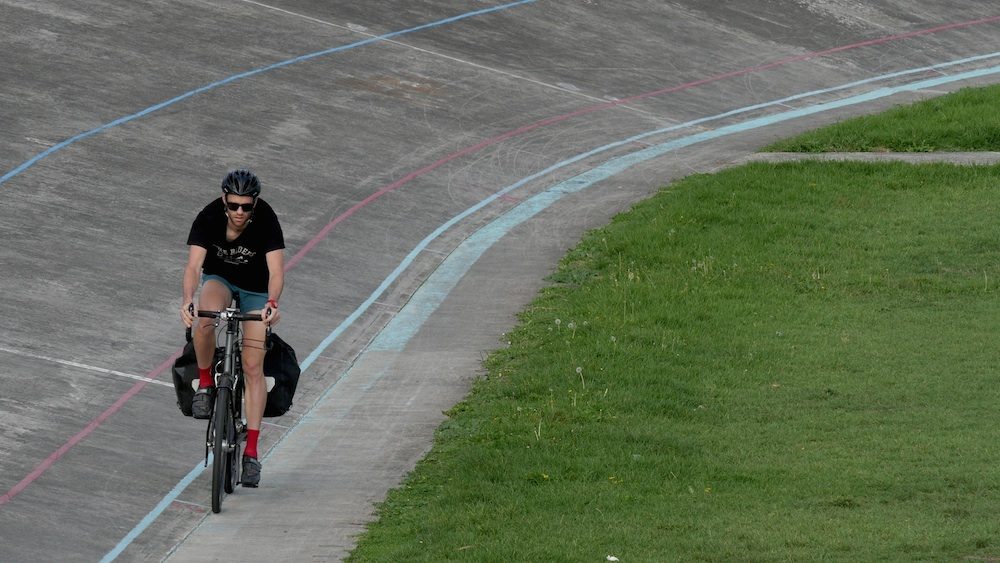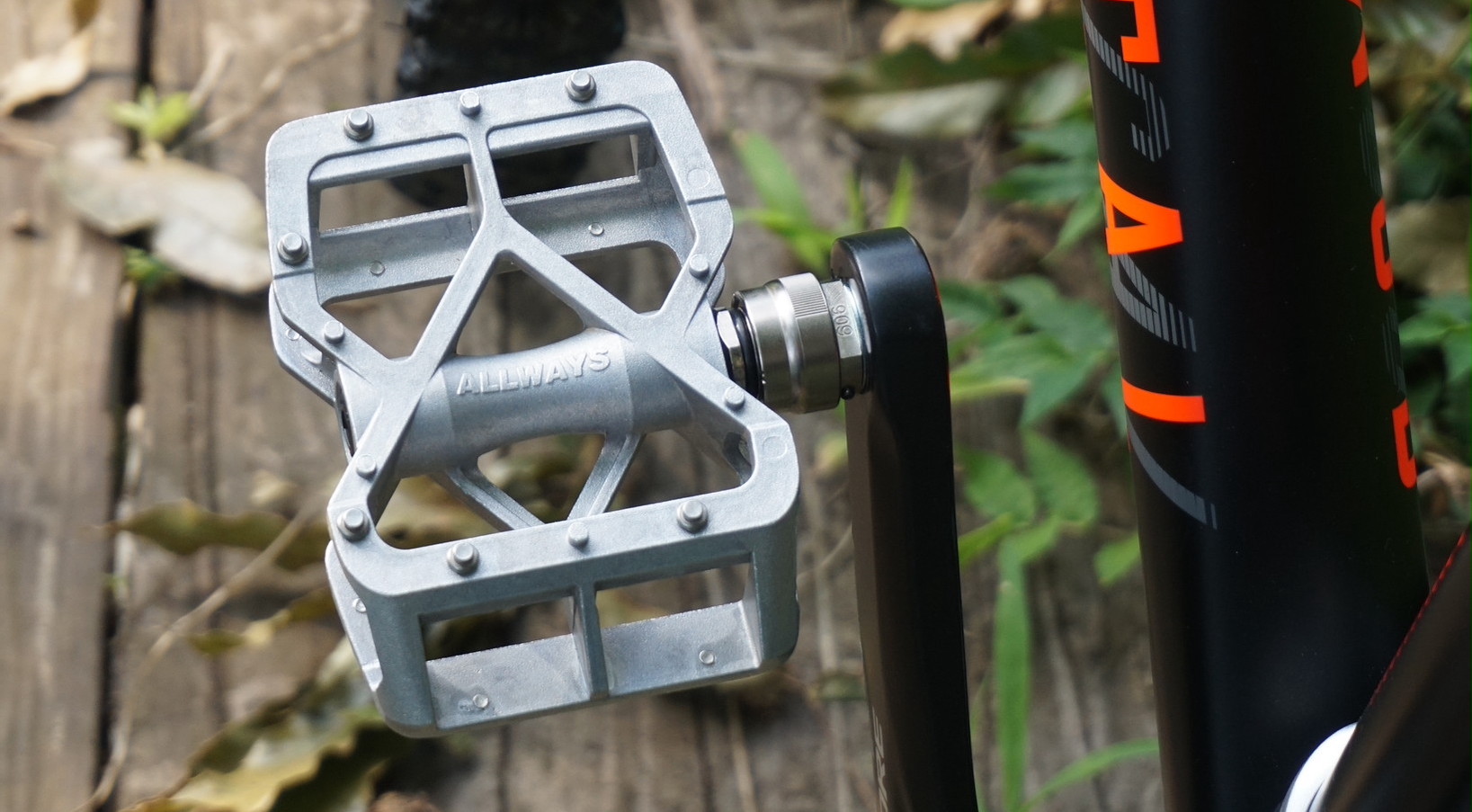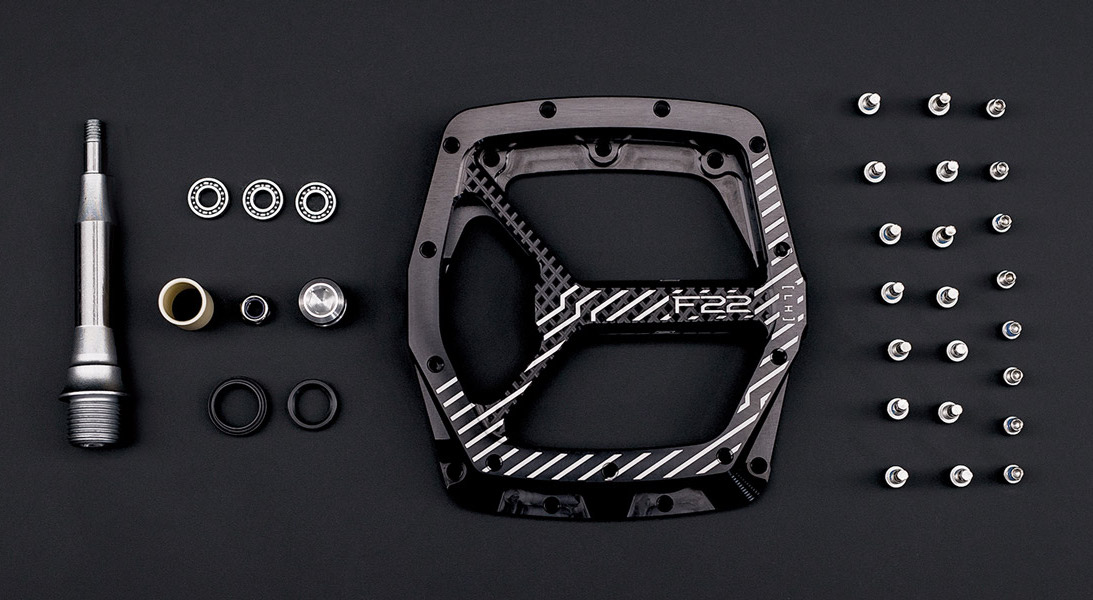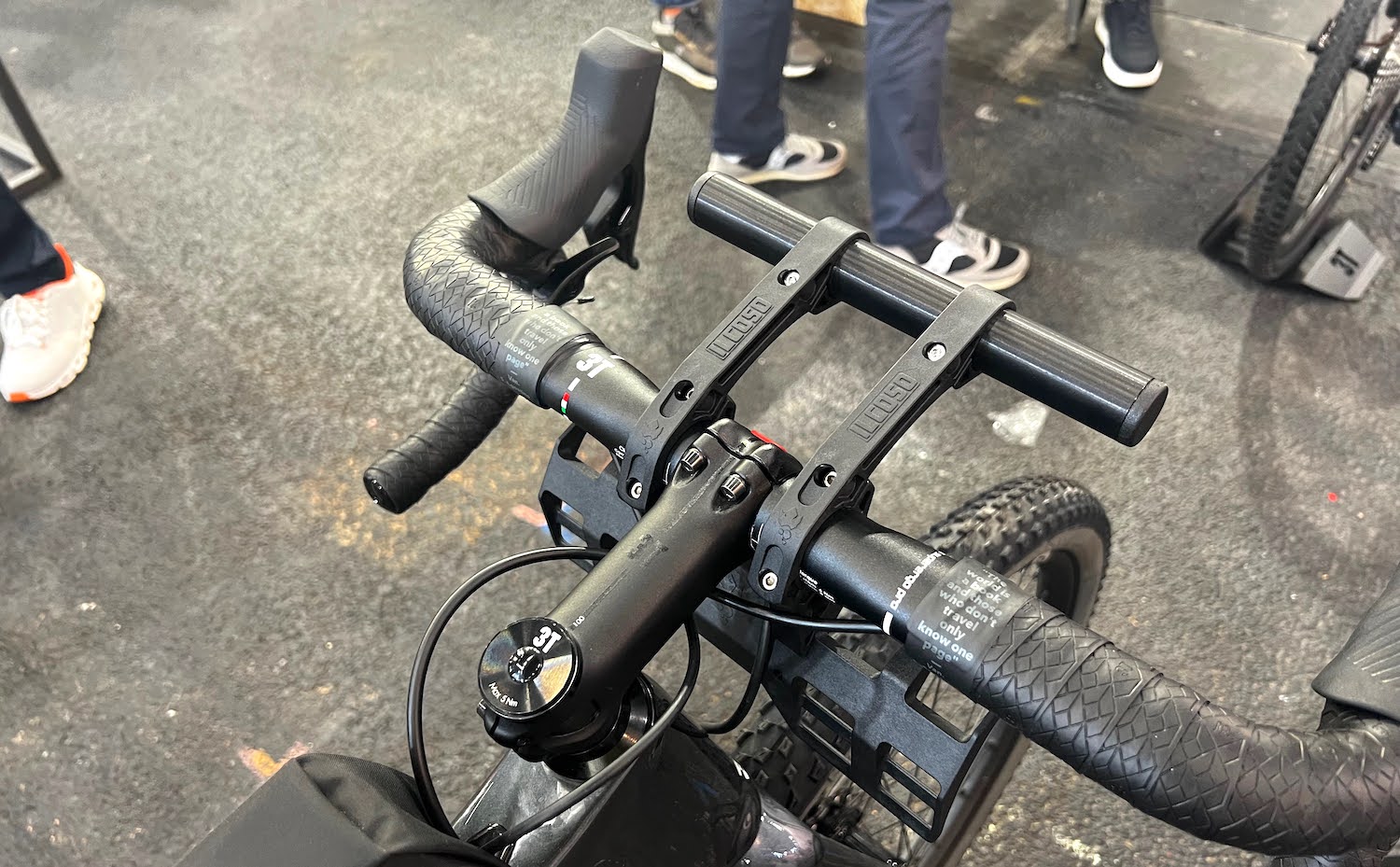Table of Contents
By the time you’re cycling at 30KPH, as much as 90% of the resistive force experienced comes from aerodynamic drag. And it’s not until you get down to 12KPH when rolling and air resistance are equal.
While most bicycle travellers do not travel at speeds above 20KPH, we still ride in places with headwinds, so I think we can all gain an advantage by thinking about aerodynamics.
Today, we’re going to take a close look at some interesting aero findings in the touring and bikepacking space, to understand how some small changes might allow us to travel further with less effort.
Super Basic Fluid Mechanics
Fluid mechanics is very complex, but if we distil it to the most basic elements relevant to bicycle touring, we end up with this drag equation:
Drag (D) consists of the air density (ρ), speed of the rider (V), frontal area (A) of the rider and the coefficient of drag (Cd).
For touring, it’s the coefficient of drag (Cd) and the frontal area (A) that we are looking to optimise when we ride our bikes. The Cd describes how aerodynamic the shape of an object is, and it’s not a fixed value – it changes depending on our touring speed, the surface textures and the air density.
Here are some approximate drag coefficients of different objects:
And here are some drag coefficients of different riding positions to compare:
1.10 – Rider sitting upright (yep, you’re as aerodynamic as a cube)
0.85 – Rider in the drops (ok, now you’re an angled cube)
0.70 – Rider in a time trial position (sorry, you’re still an angled cube)
0.10 – Fastest recumbent bicycle (finally, you’re streamlined!)
When we multiply the coefficient of drag (Cd) with the frontal area (A), we find out the CdA, or amount of drag per unit of area. To reduce our CdA, we can make our shape more aerodynamic (Cd), our frontal area smaller (A) – or both.
To get the unified hour record, it is estimated that a cyclist needs to have a CdA less than 0.2, and you need a CdA ten times less (0.02) to get the recumbent hour record!
My Velodrome Test
Five years ago, I was interested to find out what would happen if I adjusted the frontal area (A) of my luggage setup.
I conducted a test to find out the speed difference between bikepacking bags, front panniers, rear panniers and both. With a power meter fitted to my bike so I could pedal at exactly 200 watts, I cycled around a velodrome for a whole day with different bag setups to create data that was statistically significant.
The results were pretty interesting. With a higher-than-average touring speed (30KPH), two large front panniers were 6.4% slower than bikepacking bags, two large rear panniers were 6.5% slower, and a complete pannier set was 7.9% slower.
As these speeds are faster than most people travel, I would like to conduct this test again between 20 and 25KPH and I’d also like to try it with a larger volume bikepacking handlebar pack.
Cycling 100KM @ 30KPH with bikepacking bags:
Large Front Panniers: 6.4% slower (12:48 slower over 100km)
Large Rear Panniers: 6.5% slower (13:00 slower over 100km)
Front and Rear Panniers: 7.9% slower (15:48 slower over 100km)
Francis Cade’s Wind Tunnel Testing
Wind tunnels are commonly used to accurately compare the aerodynamic properties of different objects.
But one of the issues in the accuracy of the data is that the wind arrives in a steady-state, whereas wind, when you’re out cycling, is often much more turbulent. In addition, there is no ground speed in a wind tunnel and the rider is fixed in place.
A technology that might provide better data for outside conditions is aero rakes, which are commonly used in Formula 1. They can measure the flow of air behind a rider in real-time, so it will be interesting to see where this technology goes in cycling.
Back to wind tunnels – even with the inaccuracies, we can still learn information about how different luggage setups likely affect your speed.
Francis Cade made a luggage aero testing video and found a less than 1% reduction in speed when he added two bottles to his fork. With a handlebar bag added in as well, it reduced his speed by a bit over 2%. Then when he added a bikepacking seat pack – it actually made him a touch faster, likely because the airflow was separating cleaner behind his body. And the complete ensemble with panniers made him 3.6% slower, which works out to be almost 9 minutes over 100km.
Cycling 100km @ 25KPH:
Two bidons on the fork – 0.7% slower (1:45 slower over 100km)
Two bidons and a front handlebar pack – 2.1% slower (4:57 slower over 100km)
Two bidons, front handlebar pack and seat pack – 1.5% slower (3:30 slower over 100km)
Two bidons, front handlebar pack, seat pack and rear panniers – 3.6% slower (8:45 slower over 100km)
Specialized Win Tunnel Testing
Specialized has a lot of wind tunnel videos on their YouTube channel, and there are two interesting results relevant to touring.
The first is with regards to your hand positions on a flat handlebar. Most people ride in the grips, but if you can comfortably move your hands inwards near the stem and flatten your arms, that is worth a 6% gain in speed at 26KPH.
Cycling 100km @ 26KPH:
Hands in the grips – 6.2% slower (14:53 minutes slower over 100km)
The second is the difference between baggy and fitted cycling clothing. The numbers here suggest your choice of clothing is almost as important as your luggage setup, which makes sense, as your body makes up the largest percentage of your frontal area, and the drag is higher on a flappy surface.
Cycling 100km @ 30KPH:
Baggy Clothes – 5% slower (10:00 slower over 100km)
Bicycle Quarterly Wind Tunnel Testing
Bicycle Quarterly has also tested different bike and gear setups in a wind tunnel.
At 32KPH, they found that the difference between a close-fitting jacket and a looser rain jacket is an 8% difference in terms of wind resistance, which according to my estimations is around 2% slower cycling speeds.
Want to lift your bars 20mm higher? That’ll cost you 1.5% from your baseline speed.
Cycling 100km @ 32KPH/20MPH:
Raising the handlebar by 20mm results in 5% more wind resistance: ~1.5% slower (3:04 slower over 100km)
Wearing a loose rain jacket results in 8% more wind resistance: ~2.3% slower (4:30 slower over 100km)
Bicycle Quarterly also found a handlebar bag was more aerodynamic than a saddlebag, and that while a front fender reduced drag, the rear fender increased it – resulting in no overall drag penalty.
Fenders Make Your Bike MORE Aerodynamic!?
Speaking of fenders, an interesting paper came out last year, suggesting that fitting fenders/mudguards to your bike will make it more aerodynamic.
The idea is that the upper part of the fender shields the forward spinning portion of the wheel, which reduces the turbulence of the air behind the wheel, and therefore, the drag of the bike.
The study suggests that fenders with specifically 135 degrees of coverage are the sweet spot between a reduction in the drag coefficient (Cd) without too big an increase in the frontal area (A). But any longer and the larger frontal area tips this balance.
Based on my calculations, the 4.5% reduced Cd would mean that fenders could be 0.9 to 1.6% faster between 22 and 36KPH.
But this study was conducted using computational fluid dynamics, or CFD. In the bike world at least, CFD is considered more problematic than other forms of aerodynamic testing because it’s really hard to account for things like moving spokes, rotating legs and turbulent airflow.
With a 4.5 to 4.6% reduction in the Cd:
21.6KPH to 21.79KPH – 0.9% faster
28.8KPH baseline to 29.12KPH – 1.1% faster
36KPH baseline to 36.6KPH – 1.6% faster
Someone Actually Made Aero Fenders!
Some companies have actually brought wheel-shielding fenders to the market – but unfortunately, there is no independent data that I could find to verify whether they work as claimed.
Null Winds boasts claims as big as 20% faster when you’re cycling into a headwind with their fenders, which to me, sounds a bit too good to be true. Birzman also teased an aero fender set which was said to improve the wheel’s Cd by almost 4% at 48KPH, but this concept never made it to market.
Another interesting example of front-wheel shielding is found on the Ceepo Shadow R time trial bike. Again, there is no data available, which suggests to me that while some aspects of the aerodynamics might be improved, there are likely some negative downstream effects.
And lastly, we have a study by SQlab who wanted to find out whether there was a performance advantage using their Innerbarends. While riding at 36KPH on a velodrome, they found a 14-watt power difference between the Innerbarends and the grips of a flat handlebar. This works out to be a 1.8% difference in speed at the same power output.
The Savings Biggest-To-Smallest
Front and rear panniers – 7.9% slower than bikepacking bags @ 30KPH
Two large rear panniers – 6.5% slower than bikepacking bags @ 30KPH
Two large front panniers – 6.4% slower than bikepacking bags @ 30KPH
Hands in the grips, riding upright – 6.2% slower than hands near the stem, arms flat @ 26KPH
Baggy cycling clothes – 5% slower than fitted cycling clothes @ 30KPH
Two bidons, front handlebar pack, seat pack and rear panniers – 3.6% slower than no luggage fitted @ 25KPH
Loose rain jacket – 2.3% slower than a tight rain jacket @ 32KPH
Two bidons and a front handlebar pack – 2.1% slower than no luggage fitted @ 25KPH
Riding in the grips – 1.8% slower than Innerbarends @ 36KPH
Two bidons, front handlebar pack and seat pack – 1.5% slower than no luggage fitted @ 25KPH
20mm higher handlebars – 1.5% slower than baseline speed @ 32KPH
A bike without fenders – 0.9 to 1.6% slower than a bike with 135-degree fenders @ 22-36KPH
Two bidons on the fork – 0.7% slower than no luggage fitted @ 25KPH
Note: these results are not directly comparable due to the different test protocols and speeds, but it’s still interesting to see how they might rank!
Summary
Ok, so if wind tunnels, CFD and outdoor testing are all somewhat problematic, what can we take home from this?
We really just have to go back to the theory. Reducing the frontal area of your luggage will help you travel faster with the same power output. The more luggage you can jam in-line with your bike, the better – we’re talking frame packs, seat packs, top tube bags and even the area under your downtube.
Tighter fitting clothes are always going to be beneficial as the shape itself is more aerodynamic and the frontal area is smaller too.
If your body is conditioned for it, you can reduce your frontal area by changing your body position on the bike. Using my KOGA Denham Bars, I can put my hands near my stem or in my bullhorns to change my CdA – allowing me to go noticeably faster.
Or alternatively, we could all just ride aerodynamically-superior recumbent bicycles.















